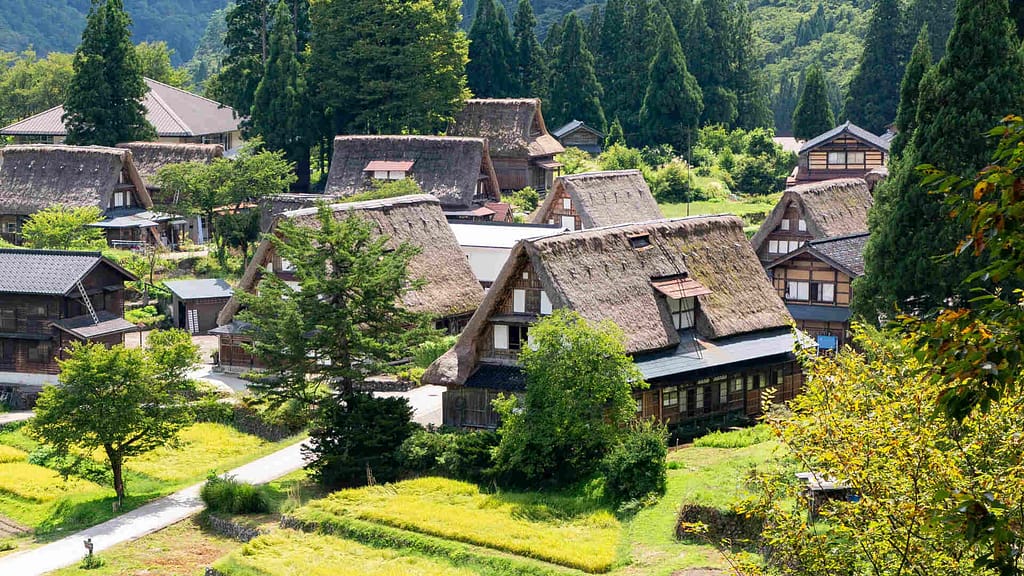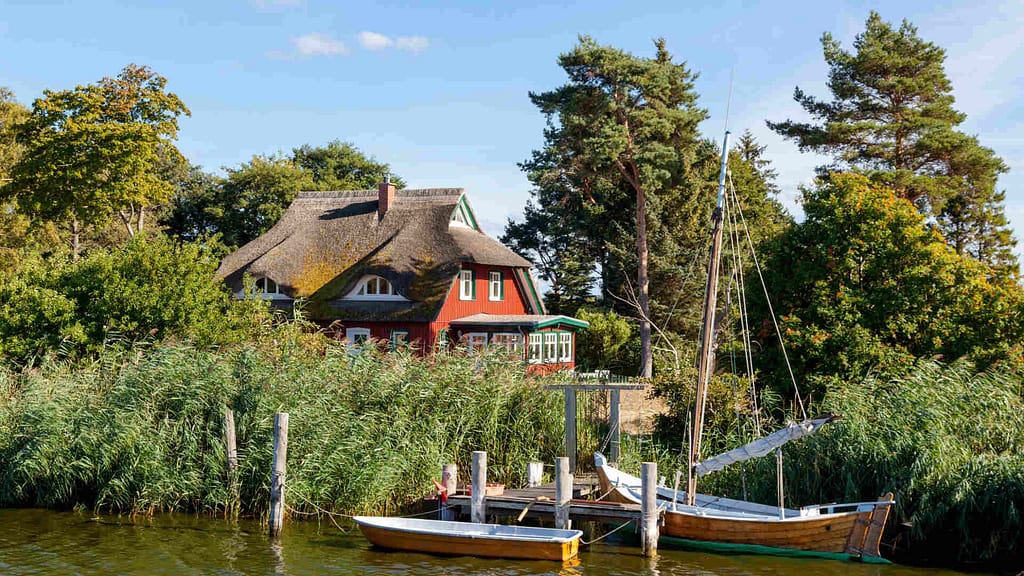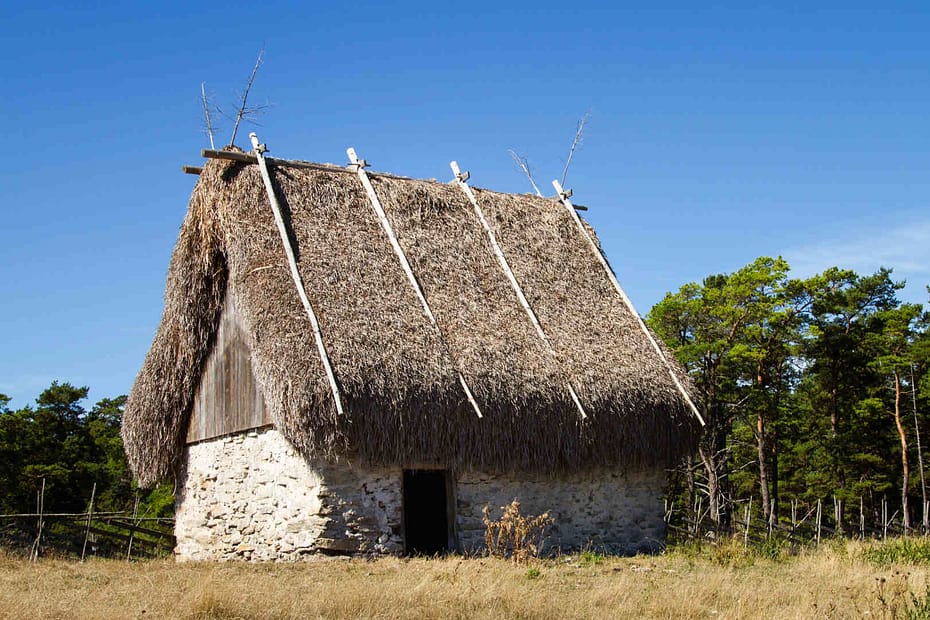Discover how long thatched roofs last, influenced by materials, craftsmanship, and care. These eco-friendly roofs blend tradition with sustainability, lasting up to 60 years.
Table of contents
What is Thatched Roofing?
Thatched roofing is one of the oldest ways to cover a house. Picture a roof not made of tiles or metal, but of plants. Evidence shows that people around the world have lived under thatched roofs. Craftsmen create thatched roofs from natural materials such as reed, straw, and palm leaves. They carefully collect these materials and layer them over each other. This creates a thick, insulating layer that keeps the house warm in winter and cool in summer.
The use of thatched roofing goes back thousands of years. It was the go-to roofing solution before modern materials became widespread. In many rural areas across Europe, Asia, and Africa, thatched roofs were favored because the materials were readily available and cost-effective. People could gather what they needed from their surroundings, making it a sustainable choice that worked well with the natural environment.
Average Lifespan of Thatched Roofs

Thatched roofs are not just about adding a traditional charm to buildings; they are also about durability. The average lifespan of a thatched roof can significantly vary depending on the materials used. Water reed, known for its strength and longevity, tops the list with a thatched roof potentially lasting up to 50-60 years when properly maintained. This makes water reed roofs among the most durable thatching options, outlasting many conventional roofing materials. Regular maintenance and care are crucial in maximizing the lifespan of any thatched roof, ensuring that this traditional roofing method continues to be a viable option for modern homes.
Factors Affecting the Lifespan of Thatched Roofs
The beauty and charm of thatched roofs can last for decades, but several key factors play a critical role in how long these roofs really last. Understanding these factors can help homeowners ensure their thatched roofs stay in top condition for as long as possible.
Quality of Materials
The durability of a thatched roof greatly depends on the type of materials used. Each material has its own average lifespan, which can influence the overall longevity of the roof:
- Water Reed: Known for its exceptional durability, water reed can last up to 50-60 years. It’s one of the most sought-after materials for thatching due to its long lifespan.
- Straw: While not as durable as water reed, straw has its own charm and can last around 20-30 years with proper maintenance. It’s a popular choice for its traditional appearance.
- Palm Leaves: Common in tropical regions like Hawaii, palm leaves vary in lifespan but generally last about 20-40 years. Their longevity can depend on the specific type of palm and the climate.
Climate and Environmental Conditions
The local weather and surrounding environment can affect how long a thatched roof lasts. Heavy rains, high humidity, and strong winds can wear down a roof more quickly. Additionally, animals and birds may damage the roof by nesting in or eating the thatch. Being aware of these factors is crucial for proper roof care and maintenance.
Craftsmanship and Installation Techniques
The skill and expertise of roofers, particularly those experienced in thatched roofing, are essential for a proper installation. Expert roofers who specialize in thatched roofs know exactly how to lay the materials tightly and uniformly. This ensures that the roof is well-protected against water and can hold up well against the elements. Their craftsmanship not only makes the roof stronger but also improves its look, showing why it’s crucial to choose roofers with specific experience in working with thatched roofs.
Maintenance and Care
Regular upkeep is essential for extending the life of a thatched roof. This includes inspecting the roof for damage, removing any build-up of moss or algae, and making timely repairs. Regular maintenance allows you to fix small issues before they become big problems, ensuring the roof remains strong and functional for many years.
Extending the Life of Your Thatched Roof

Taking care of a thatched roof means more than just admiring its beauty from the ground. To keep it looking its best and functioning properly for as long as possible, there are a few key steps you can take.
Professional Inspections
Having an expert look over your thatched roof regularly is crucial. Experienced thatchers can spot problems that you might miss, from tiny holes to areas where the thatch is wearing thin. These check-ups should happen at least once every few years to ensure everything is in top shape and to catch any issues early on.
Dealing with Moss and Algae
Moss and algae aren’t just unsightly, they can harm your roof by holding moisture against the thatch, leading to rot. To keep your roof healthy, it’s important to remove any moss or algae as soon as you spot them. For tips on how to effectively and safely remove moss from your roof, check our blog on how to remove moss from the roof. Employing gentle, eco-friendly methods to prevent their growth from the outset can also be a wise strategy to safeguard your roof’s integrity and longevity.
Timely Repairs
If you see any damage or wear on your thatched roof, it’s best to fix it right away. Small fixes can stop bigger, costly problems later. This could mean patching parts of the roof or fixing the structure underneath. Staying on top of these repairs helps your roof last longer. But, if your roof is too damaged and needs a full replacement, try our roof replacement cost calculator to get an idea of the costs.
Conclusion
Thatched roofs are more than just pretty covers for houses, they’re a smart choice for anyone thinking about the environment and looking for a roof that lasts a long time. These roofs can go strong for up to 60 years if they’re made with water reed, which is pretty impressive compared to other roofing types. The key to keeping a thatched roof in top shape includes using the right materials, taking care of it regularly, and fixing any small problems before they get big. It’s also important to have skilled people install and check on the roof now and then to make sure everything is okay.
Remember, choosing a thatched roof means you’re picking a roofing style that’s not only beautiful but also good for the planet. It’s a way to make your home stand out while also making a choice that’s good for the future. If you take good care of your thatched roof, it will keep your home cozy and look great for many years. Whether you’re already living under a thatched roof or thinking about getting one, it’s clear they offer a mix of tradition, beauty, and durability that’s hard to beat.
